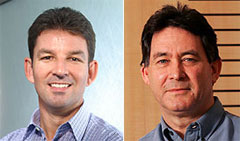Future models - Volvo - C30Expanding models bolster Volvo line-upCute hatch: The C30 echoes the venerable P1800 ES from the 1970s. Volvo's new luxury S80 sedan and C30 hatch are the start of some swift Swedes2 Oct 2006 By TIM BRITTEN WITH a relatively new boss at the helm, strong sales of its V50/S40 small car and XC70 and XC90 SUVs and a groovy small car in its not-so-distant future, Volvo is looking better in Australia than it has in years. The raw figures do not necessarily indicate it, but in the aftermath of the controversial "bloody Volvo driver" campaign – a trademark of previous managing director Steve Blyth, who late last year left to head Volvo Canada – the company is in a state of high expectancy that will be boosted by the arrival in the second quarter of 2007 of its first funky-car venture, the three-door C30. Volvo Car Australia managing director Alan Desselss said the new four-seat-only mini car would take the company into previously unexplored territory where it would hopefully attract the same type of buyer now interested in cars as diverse as BMW’s 1 series and – ironically enough – the same company’s Mini Cooper. Preceding that will be the new S80 luxury model that will start feeding into Australia later this year in preparation for its official launch, complete with the new D5 turbo-diesel and V8 engines in late January. So even if Volvo did not manage to crack 3000 sales last year and has dropped from its most recent high of 3542 sales in 2001, the prospects for 2006 look pretty good. The V50 small wagon is up almost 80 per cent on last year, the S40 sedan up 106 per cent and the XC70 and XC90 SUVs up by more than 30 per cent and almost 29 per cent respectively. Add the sales increase expected from the new V8 version of the latter – which only came as a right-hand drive late in the development program after being taken over by Volvo’s Special Vehicles wing – and 2006 could end up being something of a cracker year, with extrapolations from year-to-date figures suggesting as many as 3400 sales could be possible. The development of the V8 comes as something of an interesting decision by the company, given that even with its use in the S80 as well as the XC90, it will only mean an annual production of something like 28,000 out of the Yamaha plant in Japan. That is about 18,000 a year in XC90 global sales, and 10,000 a year for the S80. Obviously nothing out of the Ford parts bin was suitable for use in the XC90’s crowded under-bonnet confines, and obviously a V8 was sorely needed in a segment where most of the opposition has at least one on offer, but it is fair to say the decision to develop an all-new engine with such volume potential was a bold one. In Australia, the V8 is playing second fiddle to the turbo-diesel, which is expected to be the big seller in the XC90 range and will account for 50 to 60 per cent of sales. The V8 is aimed at about 10 per cent.  Former Volvo Car Australia managing director Steve Blyth and Alan Dessells, who replaced Mr Blyth from September 2005 (right). Former Volvo Car Australia managing director Steve Blyth and Alan Dessells, who replaced Mr Blyth from September 2005 (right).Volvo’s overall position in Australia will depend on the continuing success of the XC70 and XC90 as the two SUVs step in to supplant the station wagons that were once its Australian mainstay. The company is also saying the "bloody Volvo" campaign launched at the same time as the first XC90 in July 2003 was a success, although it is hardly reflected in sales figures. In fact, before the campaign the company had consistently been selling more than 3000 cars annually but dropped to 2692 in 2003 – the year the campaign kicked off. Since then sales have been trending upwards, but not spectacularly so. The only downside to this year’s performance so far is the decline of the S60 sedan and V70 wagon which are letting the side down with sales 12.6 and 21.1 per cent respectively below last year so far. Volvo has also been doing without the S80 and the S60-based C70 convertible. Treading cautiously in the wake of Steve Blyth, Mr Desselss has his eyes fixed on a more voluminous future for a company that has been under-performing in Australia when compared with its market position on other global markets. "We are not expecting to be a BMW or Mercedes," he said. "But we’d like to see Lexus or Audi volumes somewhere down the track." As Lexus sold slightly more than 6000 cars in Australia last year, and Audi managed around 4800, it would be fair to say those hopes are not unrealistic. The five-cylinder 162kW turbocharged and naturally aspirated 125kW C30 will obviously play a part in that future, although Mr Desselss said the volume expectations were quite conservative, indicating the very un-Volvo small car, which is based on a shorter version of the S40 platform, would be more of a niche model than a volume seller. The hope here, though, is that the new car will introduce Volvo to a whole new buyer group and drive the symbolic final nail into the old square-sided coffin image. |
Click to shareVolvo modelsResearch Volvo Motor industry news |














Facebook Twitter Instagram